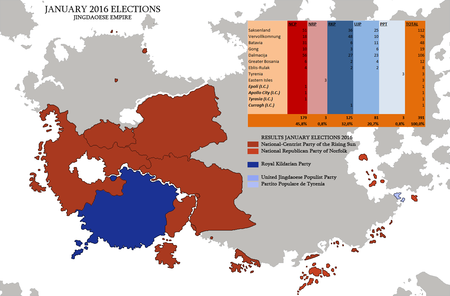1632 Assembly Elections (Jingdao)
The January 2016 Elections were the first democratic elections held in the Jingdaoese Empire since its establishment. Three major parties ran for office, the National-Centrist Party of the Rising Sun (Jingdaoese nationalists), the Royal Kildarian Party (regionalists) and the United Jingdaoese Populist Party (populists / liberals). The National Republican Party of Norfolk and Partito Populare de Tyrenia participated as well, but in coalition with the major parties.
Unexpected loss
The Nastional-Centrist Party (in coalition with the National Republican Party), backed by a strong group of industrialists, militarists and royalists, expected to gain a total victory in most States. Surprisingly, a lot of conservative voters changed their vote at the last moment, leading to unexpected victories of the Kildarian Royal Party (which capitalized on the discontent of a lot of people in the establishment).
Tyrenia became, as expected a heaven of populism, while Curagh and Vervollkomnung became powerbases of the KRP. The National Republican Party of Norfolk gained a grand victory in the only State it ran in the elections.
Results
| Party logo | Party name | Leader | Ideology | Colours | % of the total votes | % of the total seats | Seat change | Seats in January 2016 |
|---|---|---|---|---|---|---|---|---|
| National-Centrist Party of the Rising Sun | Alexander Myksos | Jingdaoese Nationalism, market centralism | Dark red | 41,52% | 45,8% | New |
179 / 391 | |
| File:KRP logo.png | Royal Kildarian Party | Theodosius Myksos | Regionalism, monarchism | Dark blue | 28,34% | 32,0% | New |
129 / 391 |
| United Jingdaoese Populist Party | Lorenzo di Focanzo Montini | Liberalism | Light blue | 18,31% | 20,7% | New |
81 / 391 | |
| National Republican Party of Norfolk | Franklin Ross | Jingdaoese Nationalism, protectionism, militarism | Red | 6,70% | 0,8% | New |
3 / 391 | |
| Partito Populare de Tyrenia | Giacomo Contarini | Liberalism | Light blue | 5,13% | 0,8% | New |
3 / 391 |
Each State is worth a certain amount of seats. This explains why the % of received votes does not necessarily result in the same % of seats.
